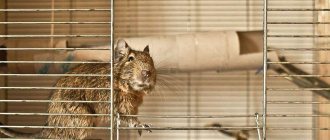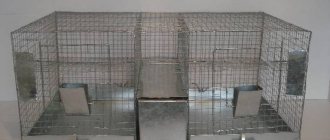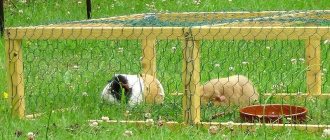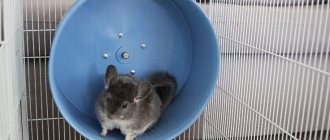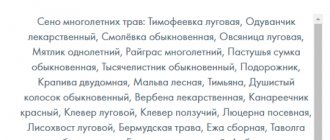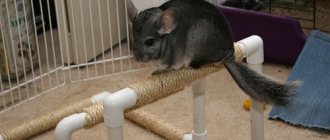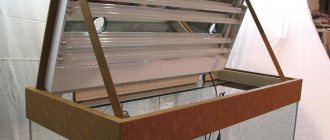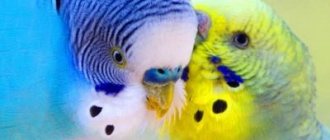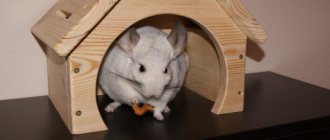Before purchasing a Chilean degu squirrel, it is important to prepare in detail everything necessary to ensure comfortable conditions for its life support. Despite its small size, the animal requires a large amount of free space. Squirrels love to move a lot, play and be interested in the world around them.
The aviary industry puts on the market high-quality products at a high cost, which can be found in every store. You can save money and reproduce a degu cage with your own hands. The project does not require large investments.
The price of the issue is the minimum cost. If you wish, you can search the Internet for advertisements of those who want to give away the cage for free.
Buying a squirrel
Buying a squirrel is quite difficult. This is a rare animal to keep at home, and it is strictly forbidden to take it home from the forest - it is a wild animal, it cannot be tamed, but it can easily be tortured to death. In this case, the squirrel may get sick.
The purchase can be made at a specialized nursery, if there is one nearby, you can try to place an order at a large pet store. At worst, you can try to go to the zoo, but you better not hope for that.
Little squirrels
Do not buy protein at the poultry market if your health is important to you.
The price of an animal varies from 5,000 rubles and above, which can also be considered an advantage of a pet.
Characteristics of a rodent
- Proportionally built body;
- Color – fiery brown, in winter – silver-fawn;
- There are long dark tassels on the ears;
- The tail is fluffy;
- Eyes – black;
- Body length - up to 31 cm. The tail is the same length;
- Weight – up to 1 kg;
- Life expectancy is up to 15 years at home. For comparison, in the wild they live 3-4 years.
The squirrel has a playful, inquisitive character and inexhaustible energy. She can spin the wheel for hours, jump off it at the same second, make a couple of dozen circles around the floors of the cage, and jump into the wheel again.
Cell research
The only thing is that at first they are cowardly, but this is just a precaution, then the squirrel will become gullible. But let us warn you - petting and cuddling her like a kitten is unlikely to work, they do not like physical affection, this is not a guinea pig
But there are also exceptions.
You also need to constantly communicate with them, because... Squirrels have a very short memory, they quickly run wild, and this is fraught with bites.
Diet
You need to feed the squirrel the same thing that it eats in nature:
- Berries;
- Fresh vegetables and fruits;
- Pine and spruce seeds;
- Mushrooms;
- Nuts (except almonds, which are poisonous to squirrels);
- Buds, shoots.
Contrary to the general belief that they are herbivores, squirrels eat insects, their larvae, frogs and shelled eggs. You can drink both water and milk. We fill the feeder 2 times a day - morning and evening, about 50 grams at a time. To prevent supplies from rotting, do not add too much food.
Squirrel eats
Never give a squirrel sweet, fried, salty, or any food from our table.
Beautiful fluffy animal
Of course, the squirrel is a very beautiful animal, but before buying, think again about whether you really need it, because there are more domestic rodents that bite and scratch less. And if you don’t change your mind, then be prepared to devote a little more time to communication than you expected, after all, the beauty, as in the photo above, is a wild animal.
And remember - we are responsible for those we have tamed!
Care instructions
A squirrel house, unlike a birdhouse, still requires certain maintenance measures. They are held once a year in the warm months, so as not to disturb the animals themselves. During cleaning, you should protect your hands with rubber gloves, which are immediately discarded. After removing the squirrel grass from the tree, you should gently shake it to throw out all the debris. If necessary, debris remains are removed mechanically.
If there were bedding or some rags inside the house, then they should be replaced with new and fresh ones. The house is washed from the inside with a wet cloth, after which it is dried with a dry cloth. If necessary, the house can be refreshed from the outside. At the end, a new litter is formed, and the house returns to its place. During cleaning, you cannot use any chemicals, as the artificial smell will repel the animals. When the house is too dirty, you can wash it with a weak soap solution, but then be sure to use ordinary water and do not forget about proper wiping.
To learn how to make a house for a squirrel, watch the following videos.
What types of homemade wheels are there?
It is a mistake to start building an attraction right away
First, you should understand the types of wheels and what criteria are important to choose a toy for an animal
First of all, we pay attention to the diameter of the simulator. It depends on the length of the pet itself
For the Syrian fluffy, the diameter of such equipment varies from 12 to 18 cm, and for the Dzhungarik - from 10 cm. If the animal is dwarf or is still in the process of growing, then a wheel with a smaller diameter is also suitable
When your pet grows up, it is important to replace the attraction with a suitable one.
The wheels also differ in the method of fastening. There are only 2 types:
- Those that are installed on a stand.
- Those that are attached to the bars of the cage.
The last option is considered to be the most safe and reliable. A wheel on a stand can cause harm to a fluffy cat if the necessary distance between the parts is neglected.
Decorative design
When decorating a house for a squirrel, it is important to avoid using paints, but you can use any interesting decorative elements that are attractive to the animal. For example, a decoration in the form of cones, attached with nails to the roof or walls of the structure, is suitable.
If the house was assembled from solid logs, then some part can be decorated using the technique of decorative wood carving. The boards themselves, which have become the walls of the house, can first be decorated with burnt pictures. A good solution would be to design the entrance area separately - to create a kind of porch, reminiscent of a birdhouse platform, so that it is easier for squirrels to get inside.
Step-by-step instructions on how to make a degu cage with your own hands
To imagine what the finished cage will look like, you can visit different pet stores and look at the products on offer. Also look at the work of other artists.
Preparatory stage
You need to start with a drawing. If you are an experienced craftsman and have a trained eye, then you can skip this step. But it’s better to make a drawing indicating all the dimensions and the amount of material needed. If you do not want to create a drawing yourself, use the proposed model.
After the drawing is transferred to paper, start preparing the necessary tools and materials.
You will need the following materials:
- nails;
- self-tapping screws or self-tapping screws;
- lining;
- wooden blocks;
- galvanized mesh;
- lock on the door.
Tools also needed:
- hammer;
- screwdriver or drill;
- hacksaw;
- metal scissors.
Make blanks based on existing drawings. Also indicate all dimensions and quantities in the drawing, and be guided by it when preparing for work. Once all the elements are ready, you can begin assembly.
Assembly
Assembly is carried out gradually, from bottom to top.
- First, assemble the bottom: make a base from wooden blocks and make a bottom from clapboard. Screw the bars with screws or self-tapping screws, so you can create a reliable base for the cage.
- Then make three walls. Screw the mesh to the base, and gradually make all three walls. For greater strength, you can make one wall from lining. Plexiglas is also a good option, in this case you will prevent the contents of the house from scattering outside.
- Separately, make another wall with a door. And leave it for now.
At this stage, it is worth taking a break and doing some internal arrangement.
If you do all the walls at once, it will be inconvenient to fill your home with various elements.
Filling
So that the animal can fully realize the need for activity, make a cage in several tiers, and place various objects inside. Among them the most suitable:
- shelves;
- thick branches;
- hammock;
- you can hang a rope along which your pet can climb to other floors;
- be sure to make a house;
- screw on the wheel (it’s easier to buy it ready-made).
Design the cage with love and care for your pet. Don’t be lazy once again to sand a sharp corner or prepare another shelf. But remember that you also cannot overdo it with filling - there should be a lot of free space in the home for comfortable movement.
Before purchasing a Chilean degu squirrel, it is important to prepare in detail everything necessary to ensure comfortable conditions for its life support. Despite its small size, the animal requires a large amount of free space.
Squirrels love to move a lot, play and be interested in the world around them.
The aviary industry puts on the market high-quality products at a high cost, which can be found in every store. You can save money and reproduce a degu cage with your own hands. The project does not require large investments.
The price of the issue is the minimum cost. If you wish, you can search the Internet for advertisements of those who want to give away the cage for free.
Let's sum it up
Assembling the ideal cage for your sugar glider will not be difficult for you, especially when you have the desire and opportunity. You just need to follow our instructions and advice.
There are many plans for collecting cell data on the Internet, using them you can easily make a wonderful home for your pet with your own hands!
Today we have considered the most important issue for all those who want to buy such a pet. Yes, this decision needs to be taken very seriously! Your animal should feel completely safe and comfortable. We also learned in general what a flying squirrel is like!
Squirrel training
Experts recommend trying to gain the squirrel’s trust from the earliest months and making attempts to train your pet. As soon as the pet becomes tame, he will be drawn to the person. Despite their tiny size, squirrels are capable of performing complex tricks.
They can not only jump high, but also dance
You can attract the degus's attention with a treat. The animal will definitely follow him
Thus, the rodent can learn to jump from knee to knee for a treat.
The “come to me” task is the most common for all types of animals. Training a degu to command “come to me” does not take much time. Especially if the animal knows in advance that it will receive a treat.
If there are several animals in the house, then you need to deal with them separately. Over time, they remember commands and easily demonstrate their skills to their owner.
In order for the result to be successful, the training process must be taken as responsibly as possible. Don't expect everything to work out right away.
Every team requires patience on the part of the owner. As soon as mutual understanding and trust are established between the owner and the pet, they will be able to perform even the most incredible tricks together.
Houses for squirrels: varieties, manufacturing features and care tips
Making bird feeders is a fairly common activity, but you can also please other forest inhabitants, such as squirrels. Creating such a design is not a difficult task. The same goes for its installation.
General design requirements
The Chilean squirrel loves space, so its home should be spacious. Animals are very active, constantly on the move. Animals will not be able to show their activity within 4 walls, so they increase the area by adding shelves.
It is recommended to choose a multi-tiered cage with 2-4 shelves. To make cleaning easier, a tray is provided. What are the basic cage requirements for a degu squirrel:
optimal size for a pair of rodents: length 1.2 m, width 0.6 m, height 1 m. For a larger number of animals, a more spacious cage is needed; Plastic and wooden parts should be avoided. The material is easily susceptible to degu teeth. Plastic, fiberboard or MDF are harmful to the health of any animal; the cage should be made of metal mesh. The optimal distance between the rods is 1 cm. If the cage contains a female with puppies, then the distance is reduced to 0.5 cm; the rods must be strong. A degu squirrel can easily cope with a mesh made of thin twigs; Chilean squirrels live in burrows. They love to dig. This is inherent in them by nature. In order for them to successfully realize their instinct, it is necessary to choose a durable pallet. It is made of aluminum sheet and plexiglass. It is possible to adapt a plastic box, but all protruding parts must be covered with aluminum tape
The rodent will not be able to grasp a smooth surface; You also need to pay attention to the door lock. A degu will learn to open a simple latch
Animals are very smart and learn quickly. It is recommended to use a carabiner as a lock.
For degus, do not choose a cage for guinea pigs, for rabbits or for chinchillas. Animals are larger than squirrels: they have a larger spacing between bars. The structures are low. Squirrels will not be able to actively run in them. Bird cages are tall, but they won't work either.
They are not wide enough or deep enough. For degus, buy a special cage in the store, make it to order, or build a home for rodents yourself. If indoor space allows, it is better to purchase a display case for degu.
To choose the optimal cell size, adhere to the following indicators. They were compiled by zoologists. At the same time, all useful areas for degus were calculated: floor, shelves, house:
- in a structure with an area of 12,000 - 14,000 cm2, only 2 rodents can be located;
- a structure with an area of 15,000 - 18,000 cm2 is intended for 3 animals;
- 19,000 – 22,000 cm2 – 4 whites;
- 23,000 – 26,000 cm2 – 5 degus;
- 27,000 cm2 – 6 rodents.
The usable area is calculated as follows:
- if the floor length is 1 m, width is 0.5 m, then the area will be 5,000 cm2.
- the cage has a shelf 60 cm long. It is located on the side wall. Its area is 3,000 cm2;
- if the usable area is 8,000 cm2, then this is not enough even for one squirrel. Increase it by installing a new level or shelf;
- a level 1 m long and 50 cm wide gives an area of 5,000 cm2. A hole is made in this panel for the passage of animals, and it is equipped with a ladder;
- The useful area in a two-tier structure with 1 shelf will be 13,000 cm2. A pair of degus can live in such a dwelling.
These calculations must be taken into account when building cells with your own hands. Experts point out some more parameters that must be observed:
- the height of the cage should not exceed 1.2 m for 2 squirrels;
- the distance between tiers or shelves is maintained no more than 35 cm;
- for adults, the distance is increased to 50 cm.
The dimensions of structures for squirrels that are displayed in stores do not always correspond to the standards, so degus breeders often assemble corners for their pets themselves.
Specifications
Creating a cage is a responsible and labor-intensive process that requires a qualitative analysis of the animal’s preferences. All materials must be durable and completely safe, since in any opportunity the degu will try to chew on the rods.
It is acceptable to use aluminum or galvanized equipment. It is strictly forbidden to use chemicals containing glue or sealant. The animal may become poisoned.
The most optimal cage size for a Chilean degu is 1.2*1*0.6 m. The dimensions allow you to house up to five adult degus. Experts do not recommend keeping pets alone.
Degus endure extreme stress, which can affect their health in the long run. The arrangement of a degu cage must be planned in advance.
What part of a watermelon can you give to a squirrel?
The squirrel should be given a small piece of red pulp only as a sweet treat. Before doing this, you need to cut off the crust. There is no need to feed the degu a lot of it often, because its body is adapted to grain food.
It is better not to pamper your rodent with this delicacy more than twice a week. Moreover, watermelon is a diuretic product, so you will often have to change the squirrel’s bedding.
Watermelon rinds and seeds on the degu menu
Many owners of decorative squirrels believe that their pet can only be limited to eating the rind of a watermelon. But this is not true, because it often collects toxic substances that can harm the pet’s health.
Moreover, there is nothing healthy in the peels, so you should not give them to the squirrel. Watermelon seeds can be given to degus little by little.
It is important to observe moderation in everything
It is forbidden to give the seeds raw; frying them is prohibited. The seeds can be stored for the winter. To do this, they are dried and systematically added to the degu's main diet.
How to choose the right watermelon?
The product you plan to treat the squirrel with must be fresh and juicy.
You should not give degus:
- unripe and rotten watermelon;
- the aroma of the berry pulp should be fresh and pleasant, without foreign odors;
- a good watermelon has a uniform flesh color;
- You cannot feed it to an animal if the flesh inside is glossy in color with yellow-white veins. This indicates the presence of nitrates.
Composition of the product
Watermelon seeds accumulate many nutritional components that are necessary for the development of the embryo and sprout. The core contains fats, proteins, carbohydrates, vitamins and mineral salts. Experts identify the following composition of watermelon seeds:
- more than 50 g of fat per 100 g of product;
- 32 g protein;
- 12% carbohydrates, which means 15 g;
- high energy value 557 kcal;
- among the vitamins there are folates; there are more than 54 mg of them in the seeds. They take part in the metabolic process, in the work of the heart and blood vessels;
- 3.6 mg of nicotinic acid - improves the condition of blood vessels, thins the blood, normalizes heart function, acid eliminates the risk of stroke.
Despite the rich chemical composition of the seeds, the squirrel needs to be fed them in limited quantities. The permitted limit is 5 pieces per week. You can't give it every day. Treats are always given after the main food has been taken.
The benefits and harms of watermelon seeds
As a tasty treat, zookeepers give squirrels sunflower, zucchini and pumpkin seeds. On the Internet and on forums you can find discussions among rodent owners: can degus be given watermelon? Experts say that you can’t feed watermelon, but you can feed it seeds.
They are considered healthy treats. When taking the seeds, stress in rodents is reduced, immunity is increased, blood circulation and microcirculation are stabilized. This is an excellent prevention against thrombosis.
If you give the seeds every day, they can cause obesity and protein intoxication in the squirrel. Foods should be given in moderation. Can you use watermelon instead of degu seeds? Veterinarians answer negatively.
The juicy pulp contains a lot of sugar, which can cause hyperglycemia and sharply increase blood sugar. It is useful to give treats to the Chilean squirrel in limited quantities. Otherwise, you will harm your pet's health, cause obesity, intoxication and diabetes.
Nest house
If you are not new to carpentry and want a whole family of squirrels , you can try organizing a nest.
The nesting house is built less high, but wider, so that the mother is comfortable with the kids. You can install several perches for babies under the entrance hole. The nest must be attached to the tree in such a way that it is not accessible to predators and is not blown by the wind . Dry leaves and hay should be laid at the bottom of the house to make it easier for the squirrel to build a nest.
So that the mother does not have to leave her babies for a long time, you can combine the house with a feeding trough . To do this, in the panel opposite from the entrance, you need to cut a round hole with a diameter commensurate with the neck of a liter jar, and make the bottom of the house longer by the height of this jar. Pour treats into a jar , insert it into the hole in the house and firmly attach it to the bottom bar with wire. The jar should be easy to remove for refilling with food.
Having built such a house for a squirrel family, it is likely that in the spring you will be able to admire the baby squirrels crawling out to bask in the sun and eat nuts from the feeder.
Housing for Degus
Of course, if you are planning to get a Degu squirrel, then you should worry about the animal’s place of residence. Iron cages with fine bars or a terrarium covered with a mesh lid on top are suitable housing for this rodent. According to reviews about Degu, it is more convenient to keep the animal in a terrarium. So, the squirrel does not have the desire to chew through the bars. In addition, debris does not spill out of the closed structure, which makes caring for the Degu much easier. However, the terrarium also has disadvantages. For example, in such a design it is more difficult to build floors for additional pallets and the “running around” of a pet. Therefore, the required area has to be increased in length or width. You need to increase the space at the rate of 95*65*45 cm for one rodent.
Also, some breeders keep Degus in aquariums covered with a net. This option is highly not recommended, since there is poor air exchange in such a container. In addition, the aquarium is not suitable for attaching a drinking bowl, a house and “toys”.
As practice shows, the opinions of owners on the issue of a place to keep an animal are divided: some choose a terrarium for reasons of cleanliness, others prefer to watch the Degu in a cage - this gives more opportunities for the rodent’s pranks and saves space.
If you have chosen a cage, you should not choose one with a plastic bottom - the rodent will simply gnaw a hole in it and run away to travel. The ideal option is a metal cage with a lattice bottom under which there is a plastic trash tray. Cleaning such a kennel is much more convenient; just remove the tray, wash it and put it back in place. The minimum cage size for degu is 80*50*40 per rodent.
The Degu cage or terrarium should be placed in a quiet, warm place without drafts or sunlight. Degus are very sensitive to changes in temperature, increased or decreased humidity, drafts and noise. Constant hypothermia (temperature below +18) is especially destructive for the animal. The ideal temperature for normal life of squirrels is +25-+26 degrees. Do not place Degus:
- near a place where there are strong odors;
- near the TV;
- in a noisy place;
- near the battery;
- near a pond or aquarium;
- under direct sunlight.
It is also worth noting that in nature Degus are mainly hunted by birds, so the animal will not feel comfortable if it is very low. If the Degu cage is on the floor, a person passing nearby will instinctively be perceived as a danger. To protect the animal from stress, it is optimal to place the pet’s cage at least 1.4 meters from the floor.
Installation Rules
Create “native” living conditions for nice new residents. When installing a squirrel cage, observe the following rules:
- fasten it to the tree;
- height - at least 5 meters from the ground, then the squirrels will feel safe;
- It is better to turn the window to the south or east;
- take into account the direction of the winds in your area - the hollow cannot be directed towards constant winds;
- put some moss or tow on the bottom - they will be useful for residents to seal cracks;
- Build a feeder next to the tree - this way your nimble friends will quickly get used to their new place.
You can create housing for squirrels yourself. Building a house will delight you and your children, and the excitement of communicating with your dear neighbors will increase noticeably.
Making a display cage
An original option could be a cage in the form of a display case. The process of creating such a structure is exactly the same as designing a wire degu cage. The degu display case differs in the constituent materials from which it is planned to create the enclosure.
The front and side walls are made of glass. The frame itself, together with the rear part, is created according to the standard scheme.
The sides are covered with galvanized mesh. The remaining parts are covered with glass. The front part of the enclosure is similar to a sideboard - two glass doors and a lock. One of the main advantages of such a display case is that leftover food, crumbs or sawdust do not fly outside the degu cage.
Through glass it is much more convenient to follow your pet - he is always in sight. Homemade cages in any form, if a person has a gift for designing and creating strong crafts, then the result is an excellent, strong structure.
Making shelves
Shelves are one of the main components of the enclosure. They are made from safe materials, most often wooden. To prevent wood from absorbing an unpleasant odor during long-term use when exposed to moisture, the surface must be disinfected and replaced regularly.
Metal shelves are strictly prohibited, as animals may develop corns. Degus love houses with several floors (levels). The shelves create just the right structure
It is important to secure them well and position them so that the possibility of a degu falling from a height is excluded.
Proper equipment will play a significant role in complementing a spacious, comfortable home. The animal will feel as comfortable as possible, ensuring a happy longevity. The most important elements for arranging degu cages are listed.
House or shelter
Despite the sociability of the pet, he needs a strong house in which he will hide and relax. The standard shelter size is 12x20x15cm. Most often, the house is created from coniferous wood.
The animal will not be able to chew through the house, since the bitter taste of the material will only repel it. Clay pots, vases or ceramics can also make good hiding places.
Sand for bathing
In order to cleanse its fur of sebum and excess moisture, degus need to constantly take a sand bath. The bathing suit should always be in the house and updated every day.
If desired, you can reduce bathing to 3 times a week. After taking the procedures, the bath needs to be taken out, since the degu can use it as a toilet.
Plain bath sand will not work. The skin is too delicate and can be injured. It is recommended to buy a specialized mixture for bathing chinchillas in a store or order online.
Wheel
The obligatory element that degus love most is the wheel. The animals constantly spin it like a spinning top. Squirrels often spin the wheel. The structure is made of organic or metal. Otherwise, it can be covered with a cloth.
This will make it easier and smoother for the degu to move around, avoiding corns.
It is important to ensure that there are no gaps in the structure. The tail can get caught in there and break easily.
The standard wheel size for squirrels is 20 cm in diameter.
Degu wheel
Hammock
The main activity of degus occurs during the daytime. They prefer to relax after games in an open area, for example, on a hammock. To create a hammock, dense natural fabric is used, without synthetics.
The hammock is hung from one of the upper corners of the enclosure. The degu climbs up the pipe to the hammock and securely settles down to rest. The bed is firmly fixed, as squirrels like to rest together.
Making a Wire Aviary
First you need to create a frame. For this you will need dry wood beams. The back wall is finished with clapboard. It is important to ensure that all elements fit tightly to each other without forming unnecessary gaps.
In order to strengthen the enclosure, it is best to use screws. The floor is created according to a similar scheme.
Wire aviary for degus
A hard surface is used as a floor covering. The floor and side walls should be covered with a mesh, the distance between the rods should be no more than 2*2cm. The door can be placed in any convenient place where it can be closed with a carabiner or lock.
Distinctive features of degus
The Chilean squirrel is small in size, but has a long tail. The body is covered with thick fur of brown color with a yellowish tint. There are lighter colored animals. Their fur is greyish and silvery. The natural color is called agouti: the hair near the body is light, it darkens towards the tip. Home breeders have bred colored degus of various colors: cognac, blue, spotted, gray. Some have a color similar to a Siamese cat. Agouti-colored individuals are found in the wild. Rodents are small, but larger than mice and dormouse. To choose the right cage for degu squirrels, you need to know how many centimeters the length of its body is:
- in an adult common degu, the body length can reach 22 cm. Larger Chilean squirrels have been found in nature. Their body length was 40 cm, but this is considered rare. The animal is active during the day. At night, rodents climb into holes. Squirrels live in families. It includes 1-2 males, 3-4 females and offspring. The leader is the largest degu;
- Bridges' degus are not as large as individuals of the common species. Their body length is 9 cm. Animals prefer rocky terrain and beech forests. They don't build burrows. In times of danger, they hide under stones and tree roots. Squirrels climb trees well and move quickly along steep cliffs. Bridges' degus are nocturnal;
- Moon-toothed degus are small rodents. Its body length is 12 cm. The animal prefers mountains. Animals can be found at an altitude of 5 thousand m above sea level. They tolerate large temperature changes well. During the day, animals are inactive. These are nocturnal squirrels. They have well-developed night vision;
- The body length of the dormouse degu is up to 18 cm. The animals are nocturnal. They spend the day in burrows, but the tunnels are not as complex as those of the common species. Rodents live under cacti and under the roots of acacias. Some animal species are common in mountain ranges. Here they do not dig underground shelters for themselves. They nest in rock crevices;
- The Pacific degu prefers a humid climate. He lives on the ocean coast. Its limbs are adapted for digging holes and climbing trees. The animal grows up to 20 cm.
All Chilean squirrels have the same tail length, 10-12 cm. It is evenly covered with bristles. Towards the end the hairs become longer. They form a fluffy brush. Its length is about 6 cm. The animal raises its tail: it is slightly rounded towards the back. You always want to touch the tassel on the tail, but you shouldn’t do this. The squirrel sheds the skin on its tail and runs away. In this way she escapes from danger. The animal gnaws off the exposed part of the tail. The wound heals quickly and the tail no longer grows back.
The body weight of the Chilean squirrel is from 130 to 300 g. The weight of newborn puppies is no more than 14 g, but they grow quickly. In the first 2 weeks, they add up to 3 g. Subsequently, up to week 6, their weight increases by 15 g per day. Puppies show their greatest growth at the age of 4-8 weeks. Weight gain per day can reach 24 g. At 8 months, the weight of the female reaches 220 g, the male 300 g. Individuals enter the puberty phase. Crossbreeding can be done at 12 months.
All degus have a very well developed sense of smell. They remember smells and hold them in their heads for a long time. Their acute sense of smell helps them hide from danger. If a domestic rodent is offended by one of the family members, a cat or a dog, then it will remember the smell of its offender and will always show aggression towards him.
The simplest option
To build a squirrel’s home, it is recommended to use a ready-made drawing , which is presented below.
This option does not require special construction tools or carpentry skills. To start building a house, you will need:
- wood hacksaw;
- measuring tape and pencil;
- screwdriver and screws;
- jigsaw for cutting out a round entrance;
- any lumber;
- sandpaper;
- first aid kit in case of minor injury.
Measure a 55x30 cm rectangle on the board and cut it out - this will be the back wall of the house. The second rectangle (50x30 cm in size) is a blank for the front side.
The two sides of the ribs will be 55x30 cm in size so that the roof of the house is at an angle to allow water to drain after rain.
The upper and lower planks are cut out measuring 30x30 cm, one of them will be the roof, and the second will be the bottom.
When creating an entrance to a house, you need to draw a circle with a diameter of about 8 cm on one of the side surfaces. The hole should be located closer to the front and top surface . The entrance must be cut out with a jigsaw and be sure to sand it.
The walls must be fastened together in the following order:
- Align the 50 cm front wall with the side panel and fasten it with self-tapping screws; on the other side, attach the second side panel with the inlet hole.
- Attach the 55 cm back wall to the side panels. Use three screws on each side.
- Attach the bottom of the house from below by screwing one screw into each corner.
- Before attaching the roof, sand down any rough areas. You can lay straw or shavings on the bottom to make the squirrels more comfortable.
- It is best to attach the roof to the back wall with door hinges so that you can clean up the house if necessary.
- Place a small porch measuring 30x5 cm under the entrance hole.
- We need to think about a system for attaching to the tree. You can drive two nails into the tree trunk, and attach rings to the back surface of the roof of the house and hang the structure from them.
- To attract new residents to the house, you need to leave a few nuts, acorns, and seeds on the porch and inside.
Distinctive features
One of the features of degus is their constantly growing powerful teeth. In order to maintain their integrity and beauty, squirrels need to eat tree branches in order to regularly grind down their teeth
As a rule, rodents try to chew anything that attracts their attention.
The owner needs to keep all the furniture in the house safe in advance while the animal is walking around the rooms. Like all living creatures, degus marks its territory. A person does not detect unpleasant odors emanating from degus, because there are none.
In a family with a small child, it is not advisable to talk about buying a degus. Children reach out to small fluffy animals to pet them, pick them up and cuddle them, which squirrels absolutely cannot stand. A pet can bite hard or injure a child’s delicate skin with sharp claws.
Bite wounds do not go away for a very long time. If a degu is in a rage, it can bite through a bone. The animal should not be picked up by the back, pulled or touched by the tail. The pet will mistake this action for attempts to attack.
What to make a feeder from?
Why do we make from plywood and not wood? Plywood is also wood. Wood veneer glued in layers. FSF plywood is waterproof, and we tested it on our feeders, houses and planters. It lived up to its characteristics. 10 years at least! Make the roof of the feeder lighter, it will not warp or crack. The most important thing is that because of the glue it almost does not rot. Glue is only harmful if burned. It is absolutely safe for squirrels outdoors. Plywood holds screws better and does not swell like wood. Here is a photo of a seven-year-old Cloud feeder. I asked the client to take a photo because I was surprised that the feeder did not fall apart. This should hang for a maximum of three to four years. We will offer feeders made of wood on a pole or pole. We make solid roofs only from plywood.
To make the animal comfortable
A degu cage should allow the animal to feel comfortable. There should be enough space for running and bustling. The cage must be very strong, since the constant running and jumping of the animal can weaken it.
When arranging a world for degus at home, you should make several transitions to different floor levels. These can be simple wooden planks, tree branches. The animal will undoubtedly chew them up over time, but they can be replaced with similar devices.
Degus also love, as those who already keep animals at home have noted, to lie in hammocks. To arrange a hammock, you can use ordinary clean burlap, firmly fixed in the cage. To entertain the animal, a rotating wheel is suitable, the kind that is usually placed in cages for rats, squirrels and other small animals.
A feeder and water bowl are required in the cage. And also a mink - the animal will sleep there.
Diet
The best food for feeding degus is guinea pig or chinchilla food. Sugar is not suitable for degus to eat, so you need to check the list of ingredients on the food packaging. Dried fruits or molasses should be avoided and not added to your pet's food. Fresh hay must be available at all times. You need to supplement your pet's diet with fresh vegetables, but not fruits, which have a high content of natural sugar. You can try offering your furry animal seeds or puffed rice.
For information on what a degu cage should be like, see below.
